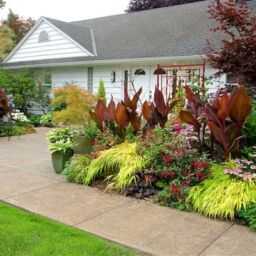Landscaping Weed Barrier Fabric – How to Install Landscape Fabric
When using landscaping fabric, preparing the project grounds is just as important as the quality of materials you use. While a lot of people will lay weed barrier directly over existing or barely prepared area, the best performance and longest lasting results are more likely with good preparation.
To Start
Measure and mark the area. Most professionals use inverted marking paint but you can also use string, sticks, rocks, hose, or whatever you have available. Buy or order your landscape fabric to make sure it’s on hand when you start your project.
Remove all vegetation
Once your project areas are measured and marked, remove all vegetation. Depending on the area you’re working on, there are several ways to remove plants and vegetation.
In lawn areas that are to be covered and / or become planting areas, we most always do a double application of a non-selective herbicide such as round up. Make sure the area is actively growing, spray the herbicide as directed, and then let it do its work. In 5 to 7 days after the application, start watering the area to encourage the growth of what may have survived and any seeds that may be viable. Repeat the herbicide application. You may also want to repeat again if necessary.
In some cases we use a sod cutter to remove the top few inches of lawn. Generally, this is after we have killed all the weeds and it is mostly done to recess the area and make room for mulch, rocks, or other ground cover.
I have seen other professionals install landscaping fabric over areas that were only sod cut but not killed with an herbicide. I don’t recommend it. Sod cutters only cut off the top surface of the grass and really do nothing for killing the roots. This could be a future problem if you have deep rooted aggressive weeds or grasses such as Bermuda.
For non-lawn and old flower bed areas, you can use the herbicide method mentioned above. And for all areas including lawn areas, you can use the herbicide method or solorization.
Solarization is basically baking the soil and exposing it to extremely high temperatures that kill weed seeds and vegetation. This process is very simple and works very well but takes the longest to do.
Prepare The Soil
If you plan on planting plants in areas where you install the fabric, you need to work in soil amendments and nutrients before installation. If possible, and I do recommend, use organic slow release nutrients and compost. You should also test the Ph of the soil and add lime or sulfur in the right amounts if needed.
Once the weed barrier is in place, you’ll only be able to add top surface applied chemical fertilizers and you won’t be able to work the soil. Of course, you can add amendments to each plant hole as you plant it. However, it’s time consuming, messy, and doesn’t extend beyond the root zone of the plant.
Use a rotor tiller or spade to turn in the amendments and nutrients 4 to 6 inches into the soil surface. Remove stones, sticks, debris, and break up clods. Rake the surface area smooth.
Install Watering System
If you have an idea of where your plants are going to be and you plan to have an automatic drip sprinkler system, now is the time to place it. Lay out your main feeder hose and run drip tube and emitters to where your plants will be. If you plan on a bubbler system, it should have been installed before the area was manicured.
Installing The Fabric
The easiest way to do this is to lay the barrier out first before you plant your plants. Some folks recommend you use securing pins to hold the material in place. It is an option. However, if you’d rather save the expense, you can hold down the edges with the ground cover you intend to use. We usually just place sacks or piles of mulch, rock, or other ground cover around the edges and spread it out after we’re done planting.
I’ve also seen a few people plant the plants first and then fit it over the tops of the plants. This is usually hard on the vegetation, breaks branches, and is very time consuming.
You can use a sharp knife or utility razor to cut the cloth but the best and easiest way we’ve found to cut long runs is to use a sharp pair of scissors. And instead of working the scissors, hold them half open to where the blades form a “V”. Hold the material where both blades in the “V” meet and push them through the cloth.
Planting
Mark your plant area or set out plants to get a visual. Use a sharp knife, razor, or scissors and cut an “x” in the fabric the size of your pot or root ball. Don’t cut the pot size out. Just cut the “x” and fold the flaps under. Make the hole. Place and plant the plant correctly. Gently place the flaps up next to the plant.
Now place 2 to 4 inches of your chosen ground cover over the area making sure to hold down the cut flaps and keep them in place.
Cut off any excess landscaping fabric around the edges making sure it stays tight around the edges.
garden landscaping
#Landscaping #Weed #Barrier #Fabric #Install #Landscape #Fabric
Will be pleased to have you visit my pages on social networking .
Facebook page here.
Twitter account is here.
Linkedin account here
Post byBedewy for info askme VISIT GAHZLY



